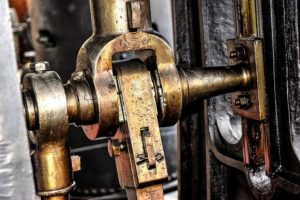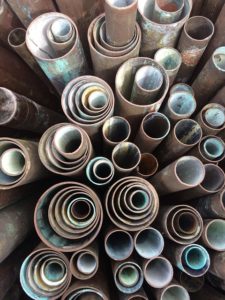Copper was discovered and first used for basic applications some 10,000 years ago. About 9,000 years later, early metallurgists found a way to alloy it with tin, giving birth to one of the most popular metals of all—bronze. That also marked the beginning of the Bronze Age. Before the last myrietes ended, another copper-based alloy had been discovered—brass—and it quickly became a sought-after material due to its incredible properties, which many claimed to be far better than those of bronze.
You may ask, if brass was revered just as much as bronze, then why wasn’t there a “brass age”? It’s true that brass came out with many useful properties, but producing it was very difficult, unlike bronze that doesn’t require special metalworking conditions. In fact, it was even believed that the discovery of brass was a complete accident, i.e. when a zinc ore-rich material was unintentionally cast with copper.
Manufacturing brass is almost impossible because copper and zinc have different melting points. Zinc melts at 787ºF and boils at about 1665ºF, which is much lower than what’s needed to melt copper and combine with zinc. The zinc vapor needed is created before copper turns into a state where it can be permeated by it. Thanks to advances in metalworking technology, creating brass has been achievable since the last millennia.
Early Production
Brass was first produced through a process called cementation, which involves melting copper with zinc-containing ground smithsonite or calamine. At a certain temperature, the zinc in calamine permeates with copper and forms brass as it cools down. Unfortunately, because the zinc involved in the process comes from another material, there’s no way to accurately measure or control its amount when introduced into the process. Normally, brass produced through cementation would consist of about 15 to 30 percent zinc.
As the use of brass spread across Asia, another production technique called speltering emerged. Unlike cementation that requires the introduction of calamine, speltering enables metallurgists to directly alloy metallic zinc with copper. Without the impurities in calamine, which are difficult to measure and segregate, they now have better control over the zinc content of brass. This means they can produce any type of brass they want to suit very specific applications.
Types of Brass
Over 60 different types of brass have been discovered so far, of which very few are commercially available as copper and brass sales. Some types of brass are especially manufactured for certain applications, while others fit virtually any known brass-based work. While each type of brass possesses distinct features, there are certain properties that they share, which is why brasses can be categorized based on similar properties.
-
Alpha Brasses.
These are brasses that contain less than 37% zinc. Reducing zinc and increasing copper content enhances brass’s corrosion resistance, electrical and heat conductivity, and appearance. Alpha brasses are also known for having a homogenous crystal structure, giving them distinct softness and ductility, which in turn allows for easy cold working, welding, rolling, drawing, and even brazing.
-
Alpha-Beta Brasses.
Brasses that contain between 37% and 45% zinc are classified as alpha-beta or duplex brasses. Having more zinc in them than alpha brasses, duplex brasses are harder to work, requiring hot working to obtain desired shape and structure. This also makes them susceptible to dezincification, a type of corrosion that leaches out zinc from brass and leaving a porous structure of pure copper. These brasses, however, are stronger and tougher than alpha brasses.
-
Beta Brasses.
As you may have guessed, beta brasses are brasses with more zinc content than the first two brass types discussed. Specifically, they contain more than 45% zinc. They are stronger and harder than alpha and duplex brasses but are also more difficult to work and more susceptible to dezincification. The only way to manufacture beta brasses is through hot working or casting.
Applications
Brass is prized for its many different valuable properties, some of which not found in other metals. This is why it is utilized for a vast array of applications. It can be manufactured into sheets, plates, tubes, and bars of any size. It can even be customized to meet highly intricate manufacturing specifications. Here are some of its major applications.
-
Small Machine Parts and Accessories.
Brass has an incredible machinability, which makes it perfect for machine parts and accessories, such as nuts, bolts, and treaded parts. Thanks to its high corrosion resistance, it is also the preferred material for clock parts, builder’s hardware, plugs, lamp fittings, and gear meters. Most machine terminals, jets, injectors, and valve bodies are also made of brass. No other metal performs better in these applications than brass, so is copper or brass more expensive than their counterparts? The answer is a whopping yes but it’s definitely worth it.
-
Structural and Architecture.
Ever wondered why your doorknobs and their hinges or some of the trims and railings in your home look nothing like the steel bars you see in construction sites? That’s because these structural and architectural elements are made of copper-based materials, mostly brass. In fact, since brass is corrosion resistant, it can also be used to make fascia that complements the most elaborate architectural designs.
-
Large Machine Parts and Vehicles.
Brass has also been the material of choice for many equipment and vehicle manufactures for some parts of their designs. It is used in marine engines, hydraulic equipment fittings, locomotive axle boxes, pump casting, heavy rolling mill housing nuts, and heavy load wheels. The main reason brass is the best material for these applications is that it has considerably low friction and thermal coefficient as well as high resistance to saltwater corrosion.
-
Plumbing.
Copper-based materials are well-known for having antimicrobial properties, too. They literally kill bacteria that attempt to cling on to their surface. As such, they are perfect for plumbing applications, such as pipes for waterways and sewers.
When choosing brass supplies, take quality and appropriate grade into account as not all brasses are the same. You can tell which ones are of superior quality by comparing copper and brass prices. The expensive ones are usually of higher grade. However, to be absolutely sure you are purchasing the perfect brass for your project, go to a reputable supplier like Rotax Metals. Not only do they offer a vast selection of brass supplies, but they are also highly skilled in picking the right product for specific purposes.




